Hi E
Well I was hoping someone else would have helped yopu out here first, but they haven't so I'll give you my 2p.
I would say It Depends. It depends on what sort of work you intend to do in the future. If you are planning to makes gates and bigger (architectural woodwork generally, doors, windows etc) then bite the bullet now and buy a decent mortiser. It will give you a bigger capacity than you can get with a router (although I have successfully mortised through 4" stock with a router).
But there are downsides, apart from the capital outlay. A mortiser takes up valuable floor space, and my guess is, if it's anything like mine, you won't use it that often, at least not compared to, say, a tablesaw or router table.
If these gates are the biggest thing you are likely to make in the foreseeable future, save your money and make a good mortice jig. It will take up a lot less room and give you perfect results. In fact the mortices I rout are much cleaner thn the ones I get with my mortiser. You will need mortising cutters though, I can recommend the Clico ones. They are actually intended for horizontal mortisers, have a serrated edge for chip clearance and do not like to be run as fast as a router does, so you do have to take care, especially with the 1/4" ones, but they perform superbly.
FWIW, lat year I decided to get rid of my mortiser because I never use it, but my friend and neighbour talked me out of it. So I said, "Well, if you want me to keep it, you house it, I need the space". So he did, and I'm very glad, because making dsoors and windows as I'm doing now would have been more work with a router. But this is the first time I've needed it in nearly 2 years.
So you pays your money and you takes your choice. Jig for small/medium work, mortiser for medium/large.
HTH
Steve






